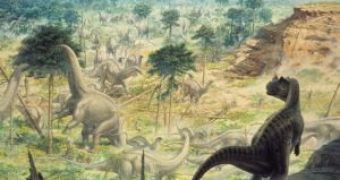Dinosaurs ("terrible lizards") went extinct 65 million years ago, but since their discovery two centuries ago, they sparked the imagination of the people, and not only of the scientists!
These reptiles ("crawly animals", what an ugly name for a group encompassing such amazing animals like the dinosaurs) are not lizards at all, and what first impressed was their sheer size compared with their current relatives (except crocodiles and giant snakes). But don't get fooled, most dinosaurs were not so impressive.
Now the public interest on dinosaurs is confronted with a "golden age" of new dinosaur discoveries. Investigations of new pristine territories on dinosaur hunting, like China, Mongolia and South America, has increased exponentially the number of new dinosaur species findings over the past few years.
The palaeobiologist Dr Peter Dodson, of the University of Pennsylvania, estimated through statistics that more than 71 % of "discoverable" dinosaurs are awaiting discovery. "Historically, between 1824 (when William Buckland, an Oxford professor of geology, first described a dinosaur fossil, Megalosaurus, a 9 m long carnivorous) and the 1970s, the rate of description of new dinosaurs was one of 1.1 per year - 11 per decade was the average. Then, between 1970 and 1990, the rate of description of new dinosaurs went up to six per year - 60 per decade - and that's a big jump."
"But between 1990 and 2004, the rate jumped to 15 and in some years 24 per year. I've described four new kinds of dinosaurs, and one of my students and colleagues, Hai-lu You, described five new kinds of Chinese dinosaur in one year - a feat which, to the best of my knowledge, no other scientist has ever done."
Since 1990, the new dinosaur species increased by 85 %. Dinosaur palaeontology is now already the privilege of "white Anglo-Saxons", with the new fruitful fossil beds opened up worldwide. The greatest areas for dinosaur hunting have been till recently the rocks of Montana and Wyoming in the US. "Now the top three countries are the US, China and Argentina - because all three have rocks which span much of the age of dinosaurs (across Triassic, Jurassic and Cretaceous periods). Canada and Mongolia both have wonderful dinosaurs, but from a much more limited time frame, in the Cretaceous period," said Dodson.
In some areas, even if containing dinosaur rich geological structures, the fossils are not accessible due to current ecology, as the desert normally fully exposes the fossil beds. England is one example of it. "You've got rocks laid down when the dinosaur were about, running from the Isle of Wight, right through the Midlands and coming out at the Yorkshire coast," said Steve Hutt, the curator of the Dinosaur Isle museum on the fossil-rich Isle of Wight.
"If [Britain] was a desert, nothing would stop us from getting at these things. But there's all that bloody scrub and trees and grass on top here."
Amongst recent astonishing dinosaur discoveries, some have fulfilled public necessity for sensational: the Cretaceous carnivorous Giganotosaurus, which left chicken sized the charismatic prehistoric dragon, Tyrannosaurus rex; or the long-necked plant-eater Argentinosaurus, till now not the largest dinosaur, but the largest land animal that ever lived; other discoveries bear an extreme relevance from a scientific point of view, like Chinese "dinobirds" in China, that further strengthen the hypothesis of dinosaur origin of the birds.
Amazingly, American researchers have managed to get recently even dinosaur soft tissue: blood and bone cells, with even suggestions of nuclei, from Tyranosaurs rex femurs and skin portions from a duckbilled dinosaur (previously skin impressions have been found).

 14 DAY TRIAL //
14 DAY TRIAL //